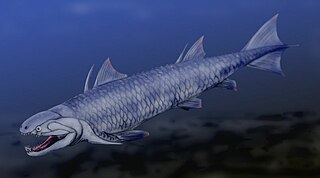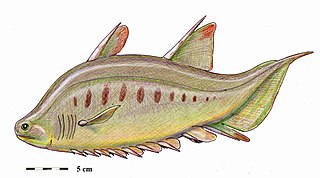
Chondrichthyes is a class of jawed fish that contains the cartilaginous fish or chondrichthyians, which all have skeletons primarily composed of cartilage. They can be contrasted with the Osteichthyes or bony fish, which have skeletons primarily composed of bone tissue. Chondrichthyes are aquatic vertebrates with paired fins, paired nares, placoid scales, conus arteriosus in the heart, and a lack of opecula and swim bladders. Within the infraphylum Gnathostomata, cartilaginous fishes are distinct from all other jawed vertebrates.

Gnathostomata are the jawed vertebrates. Gnathostome diversity comprises roughly 60,000 species, which accounts for 99% of all living vertebrates, including humans. In addition to opposing jaws, living gnathostomes have true teeth, paired appendages, the elastomeric protein of elastin, and a horizontal semicircular canal of the inner ear, along with physiological and cellular anatomical characters such as the myelin sheaths of neurons, and an adaptive immune system that has the discrete lymphoid organs of spleen and thymus, and uses V(D)J recombination to create antigen recognition sites, rather than using genetic recombination in the variable lymphocyte receptor gene.

Sarcopterygii — sometimes considered synonymous with Crossopterygii — is a taxon of the bony fish known as the lobe-finned fish or sarcopterygians, characterised by prominent muscular limb buds (lobes) within the fins, which are supported by articulated appendicular skeletons. This is in contrast to the other clade of bony fish, the Actinopterygii, which have only skin-covered bony spines (lepidotrichia) supporting the fins.

Placodermi is a class of armoured prehistoric fish, known from fossils, which lived from the Silurian to the end of the Devonian period. Their head and thorax were covered by articulated armoured plates and the rest of the body was scaled or naked, depending on the species. Placoderms were among the first jawed fish; their jaws likely evolved from the first of their gill arches.

Teleostomi is an obsolete clade of jawed vertebrates that supposedly includes the tetrapods, bony fish, and the wholly extinct acanthodian fish. Key characters of this group include an operculum and a single pair of respiratory openings, features which were lost or modified in some later representatives. The teleostomes include all jawed vertebrates except the chondrichthyans and the extinct class Placodermi.
The Climatiiformes is an order of extinct fish belonging to the class Acanthodii. Like most other "spiny sharks", the Climatiiformes had sharp spines. These animals were often fairly small in size and lived from the Late Silurian to the Early Carboniferous period. The type genus is Climatius. The order used to be subdivided into the suborders Climatiida and Diplacanthida, but subsequently Diplacanthida has been elevated to a separate order, the Diplacanthiformes. The Diplacanthiformes take their name from Diplacanthus, first described by Agassiz in 1843. Family Gyracanthidae is sometimes rejected from this order.

Psarolepis is a genus of extinct bony fish which lived around 397 to 418 million years ago. Fossils of Psarolepis have been found mainly in South China and described by paleontologist Xiaobo Yu in 1998. It is not known certainly in which group Psarolepis belongs, but paleontologists agree that it probably is a basal genus and seems to be close to the common ancestor of lobe-finned and ray-finned fishes. In 2001, paleontologist John A. Long compared Psarolepis with onychodontiform fishes and refer to their relationships.

Ischnacanthus is an extinct genus of jawed fish in the class Acanthodii. It lived during Pridoli to Lochkovian, type species I. gracilis is only known from Lochkovian.
Guiyu oneiros is one of the earliest articulated bony fish discovered. Fossils of Guiyu have been found in what is now Qujing, Yunnan, China, in late Silurian marine strata, about 425 million years old.

Most bony fishes have two sets of jaws made mainly of bone. The primary oral jaws open and close the mouth, and a second set of pharyngeal jaws are positioned at the back of the throat. The oral jaws are used to capture and manipulate prey by biting and crushing. The pharyngeal jaws, so-called because they are positioned within the pharynx, are used to further process the food and move it from the mouth to the stomach.

The evolution of fish began about 530 million years ago during the Cambrian explosion. It was during this time that the early chordates developed the skull and the vertebral column, leading to the first craniates and vertebrates. The first fish lineages belong to the Agnatha, or jawless fish. Early examples include Haikouichthys. During the late Cambrian, eel-like jawless fish called the conodonts, and small mostly armoured fish known as ostracoderms, first appeared. Most jawless fish are now extinct; but the extant lampreys may approximate ancient pre-jawed fish. Lampreys belong to the Cyclostomata, which includes the extant hagfish, and this group may have split early on from other agnathans.

Brochoadmones is an extinct genus of acanthodian from the Devonian of what is now Canada. It is the only genus in the suborder Brochoadmonoidei, whose relationship to other acanthodian orders remains currently in flux.

Entelognathus primordialis is an early placoderm from the late Silurian of Qujing, Yunnan, 419 million years ago.

Qilinyu is a genus of early placoderm from the late Silurian of China. It contains a single species, Qilinyu rostrata, from the Xiaoxiang fauna of the Kuanti Formation. Along with its contemporary Entelognathus, Qilinyu is an unusual placoderm showing some traits more similar to bony fish, such as dermal jaw bones and lobe-like fins. It can be characterized by adaptations for a benthic lifestyle, with the mouth and nostrils on the underside of the head, similar to the unrelated antiarch placoderms. The shape of the skull has been described as "dolphin-like", with a domed cranium and a short projecting rostrum.
This list of fossil fishes described in 2017 is a list of new taxa of jawless vertebrates, placoderms, acanthodians, fossil cartilaginous fishes, bony fishes and other fishes of every kind that are scheduled to be described during the year 2017, as well as other significant discoveries and events related to paleontology of fishes that are scheduled to occur in the year 2017. The list only includes taxa at the level of genus or species.

Ptomacanthus is an extinct genus of spiny shark, an early relative of living cartilaginous fishes.

Bianchengichthys is a genus of maxillate placoderm fish from the late Silurian Period. Its fossils have been recovered from Yunnan Province, China, and it is represented by only one species: Bianchengichthys micros.

Qianodus is a jawed vertebrate genus that is based on disarticulated teeth from the lower Silurian of China. The type and only species of Qianodus, Q. duplicis, is known from compound dental elements called tooth whorls, each consisting of multiple tooth generations carried by a spiral-shaped base. The tooth whorls of Qianodus represent the oldest unequivocal remains of a toothed vertebrate, predating previously recorded occurrences by about 14 million years. The specimens attributed to the genus come from limestone conglomerate beds of the Rongxi Formation exposed near the village of Leijiatun, Guizhou Province, China. These horizons have been interpreted as tidal deposits1 that form part of the shallow marine sequences of the Rongxi Formation.

Fanjingshania is an extinct genus of acanthodian from the lower Silurian of China around 439 million years old, making it currently the oldest known acanthodian. It comprises a single species, Fanjingshania renovata which is known from over 1,000 isolated elements, including fin spines, branchiostegal plates, sclerotic plates, trunk scales, and tectal and postorbital tesserae. No teeth were ascribed to the taxon, but in the same horizon the tooth taxon Qianodus was found, and these taxa may be synonymous. In a phylogenetic analysis accompanying the description, it was placed in a clade with Climatius, Parexus, and Ptomacanthus.




















